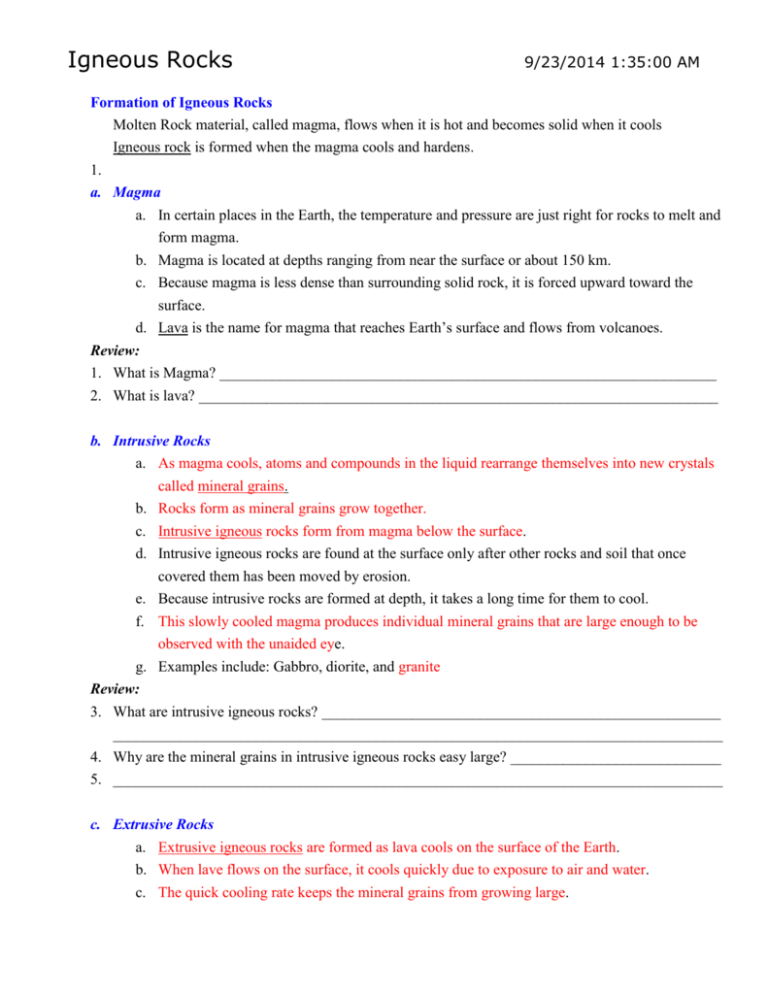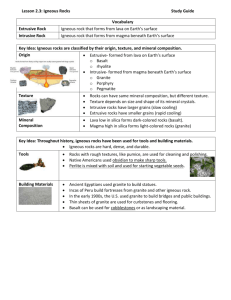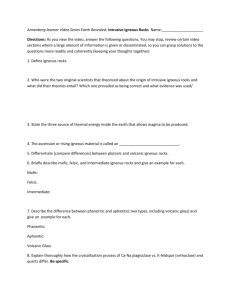Igneous Rocks Study Notes
advertisement

Igneous Rocks 9/23/2014 1:35:00 AM Formation of Igneous Rocks Molten Rock material, called magma, flows when it is hot and becomes solid when it cools Igneous rock is formed when the magma cools and hardens. 1. a. Magma a. In certain places in the Earth, the temperature and pressure are just right for rocks to melt and form magma. b. Magma is located at depths ranging from near the surface or about 150 km. c. Because magma is less dense than surrounding solid rock, it is forced upward toward the surface. d. Lava is the name for magma that reaches Earth’s surface and flows from volcanoes. Review: 1. What is Magma? __________________________________________________________________ 2. What is lava? _____________________________________________________________________ b. Intrusive Rocks a. As magma cools, atoms and compounds in the liquid rearrange themselves into new crystals called mineral grains. b. Rocks form as mineral grains grow together. c. Intrusive igneous rocks form from magma below the surface. d. Intrusive igneous rocks are found at the surface only after other rocks and soil that once covered them has been moved by erosion. e. Because intrusive rocks are formed at depth, it takes a long time for them to cool. f. This slowly cooled magma produces individual mineral grains that are large enough to be observed with the unaided eye. g. Examples include: Gabbro, diorite, and granite Review: 3. What are intrusive igneous rocks? _____________________________________________________ _________________________________________________________________________________ 4. Why are the mineral grains in intrusive igneous rocks easy large? ____________________________ 5. _________________________________________________________________________________ c. Extrusive Rocks a. Extrusive igneous rocks are formed as lava cools on the surface of the Earth. b. When lave flows on the surface, it cools quickly due to exposure to air and water. c. The quick cooling rate keeps the mineral grains from growing large. d. Therefore, extrusive igneous rocks are fine grained. e. Examples include: Basalt, scoria, andesite, rhyolite, pumice, obsidian. d. Volcanic Glass a. Rocks that cooled so quickly that few or no mineral grains formed b. Examples are pumice, obsidian, and scoria. c. In the cases of pumice and scoria, gases become trapped and often leave behind holes where the rock formed around the pocket of gas. Classifying Igneous Rocks Igneous rocks are extrusive or intrusive depending on how they are formed. These rocks are further classified by the magma they are formed from. e. Basaltic Rock a. Basaltic igneous rocks are dense, dark-colored rocks b. Form from magma rich in iron and magnesium and poor in silica c. The presence of iron and magnesium gives basalt its dark color. d. Examples include: Gabbro, basalt, scoria f. Granitic Rock a. Granitic igneous rocks are light colored rocks of lower density than basaltic rocks. b. Granitic magma is thick and stiff and contains lots of silica, but lesser amounts of iron and magnesium. c. Because it is stiff, granitic magma can build up a great deal of gas and pressure, which is released explosively during violent volcanic eruptions. d. Examples include: Granite, rhyolite, pumice, obsidian g. Andesitic Rocks a. Have mineral compositions between those of basaltic and granitic rocks. b. Many volcanoes around the Pacific Ocean form andesitic magmas. c. These volcanoes can erupt violently. d. Examples include: Diorite, andesitic 9/23/2014 1:35:00 AM 9/23/2014 1:35:00 AM






